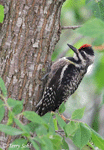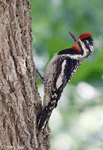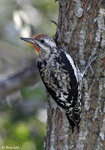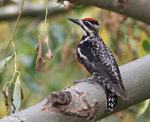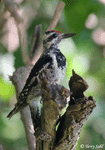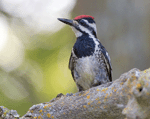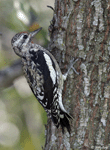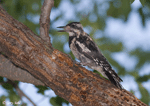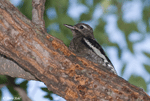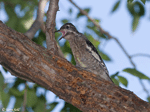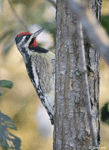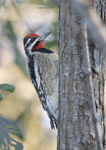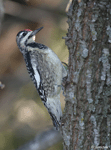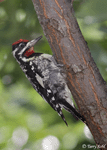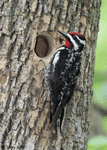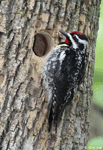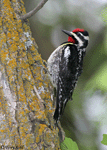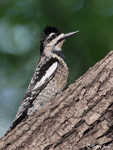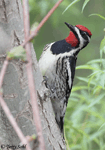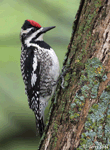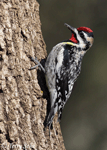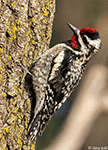| Length: 8.5 inches | Wingspan: 16 - 18 inches | Seasonality: Migrant / Summer |
| ID Keys: Long white stripe on wing, spotted back, stripes on face. Male have red throat, Females have white throats. | ||
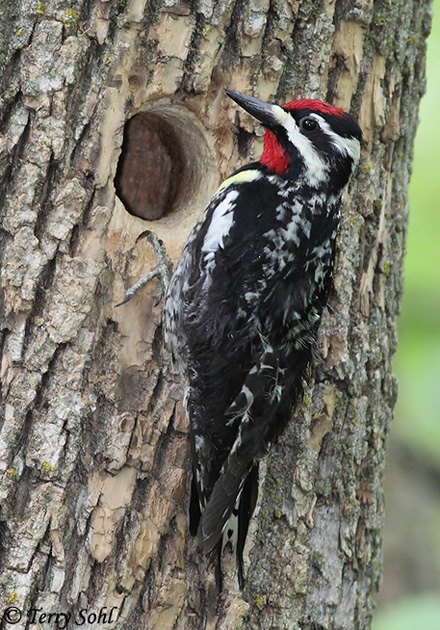 Not a Warner Brothers cartoon character, but an actual bird. The closely related Red-naped
Sapsucker is very similar, but ranges are distinctly different. As the
name implies, Sapsuckers drill a series of wells in trees and drink the sap that
oozes forth. They are often quite important ecologically for a given
habitat, as several other animal species use sapsucker wells for feeding.
Male Yellow-bellied Sapsuckers are quite territorial, and can often be heard
banging out their territorial drumming. They've come to learn that metal
signs and other metal objects can amplify the drumming sound, and thus
individual birds may return to a given sign time and time again in order to
reinforce their control over a territory. The photo to the right shows a
male at a nest hole. Females are similar in plumage but lack the red on the
throat.
Not a Warner Brothers cartoon character, but an actual bird. The closely related Red-naped
Sapsucker is very similar, but ranges are distinctly different. As the
name implies, Sapsuckers drill a series of wells in trees and drink the sap that
oozes forth. They are often quite important ecologically for a given
habitat, as several other animal species use sapsucker wells for feeding.
Male Yellow-bellied Sapsuckers are quite territorial, and can often be heard
banging out their territorial drumming. They've come to learn that metal
signs and other metal objects can amplify the drumming sound, and thus
individual birds may return to a given sign time and time again in order to
reinforce their control over a territory. The photo to the right shows a
male at a nest hole. Females are similar in plumage but lack the red on the
throat.
Habitat:
Can be found in nearly any kind of forest during migration. Generally in deciduous to mixed forest in the summer.
Diet:
Other than sap, eats insects attracted by their sap wells. Also eats fruits and berries.
Behavior:
While much of the diet may be tree sap, they also often glean insects from branches as do other woodpeckers. They also may catch insects in mid-air.
Nesting:
Late May through July in South Dakota. Yellow-bellied Sapsuckers are cavity nesters, building their nests in trees that often have a fungal infection that makes the heartwood easier to excavate. The male constructs the nest, building a cavity with a small entrance hole but an inside cavity that may reach 10-12 inches in depth. No lining is placed in the nest outside of wood chips from the excavation itself. The female lays 4 to 7 eggs, with both parents helping to incubate them. The young hatch after about 13 days, and don't fledge from the nest until about 3 to 4 weeks from hatching.
Song:
Yellow-bellied Sapsuckers have a variety of calls. The most common is a mewing type of call that descends in pitch.
- Click here to hear the typical mewing-like call of a Yellow-bellied Sapsucker1
- Click here to hear the drumming of a Yellow-bellied Sapsucker2
- Click to hear the agitated calls of a small group of interacting Yellow-bellied Sapsuckers3
Migration:
While most woodpeckers in the United States are not know for long migration, the Yellow-bellied Sapsucker is strongly migratory, wintering in the southeastern U.S. down through Central America, and summering in the northern U.S. and Canada.
Interactive eBird map:
Click here to access an interactive eBird map of Yellow-bellied Sapsucker sightings
Similar Species:
Range separates Yellow-bellied Sapsuckers from most similar species, but there may be confusion in some select locations with the following species:
- Red-naped Sapsucker - The equivalent species of the western part of North America, Red-naped Sapsuckers are very similar in appearance to Yellow-bellied Sapsuckers. However, Red-naped Sapsuckers have a red spot on the back of the neck (nape) that is lacking on Yellow-bellied Sapsuckers. In terms of range, there's very little overlap, but the two species could potentially both be found in far western South Dakota.
- Williamson's Sapsucker - There's normally rarely any overlap in range among the two species, but Williamson's Sapsuckers could be confused with a Yellow-bellied Sapsucker (may sometimes occur in the western US with wayward migrant Yellow-bellied Sapsuckers). Williamson's Sapsuckers have a solid black back compared to the white and black barred back of a Yellow-bellied Sapsucker. Williamson's Sapsuckers also lack the red forehead stripe of a Yellow-bellied Sapsucker and have a smaller red throat patch.
- Downy Woodpecker - Of the species on this list, Downy Woodpeckers are the most likely to be found in the same locations as Yellow-bellied Sapsuckers. Downy Woodpeckers have a smaller bill, a a clean white patch on the back (compared to black and white barring on the back of a Yellow-bellied Sapsucker). Downy Woodpeckers also lack the white wing patch, red forehead stripe, and red throat found on Yellow-bellied Sapsuckers.
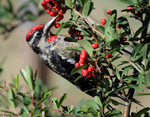 |
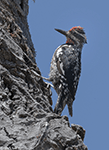 |
 |
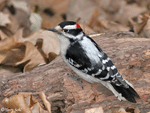 |
| Red-naped Sapsucker | Red-naped Sapsucker | Williamson's Sapsucker | Downy Woodpecker |
Feeders:
Will occasionally attend feeders for fruit. They also will sometimes come to hummingbird feeders for nectar, and occasionally feed on suet.
Conservation Status:
Yellow-bellied Sapsuckers have become much less common in parts of their range, primarily due to the loss of suitable nesting habitat. However, populations are generally stable, they are common in many parts of their range, and they are found over a broad geographic area. The IUCN considers the Yellow-bellied Sapsucker to be a species of "Least Concern".
Further Information:
- WhatBird - Yellow-bellied Sapsucker
- BirdWeb - Yellow-bellied Sapsucker
- Audubon Field Guide - Yellow-bellied Sapsucker
Photo Information:
May 21st, 2010 - Near Brandon, South Dakota -- Terry L. Sohl
Additional Photos:
Click on the image chips or text links below for additional, higher-resolution Yellow-bellied Sapsucker photos.
Audio File Credits:
- 1Sue Riffe. Recorded on Big Creek Road, Michigan on May 11th, 2018. Original recording and information from xeno-canto.
- 2Scott Gravette. Recorded in Carter County, Tennessee on June 13th, 2018. Original recording and information from xeno-canto.
- 3Andrew Spencer. Recorded in Hampshire County, Massachusetts on April 18th, 2010. Original recording and information from xeno-canto.
| Click on the map below for a higher-resolution view |
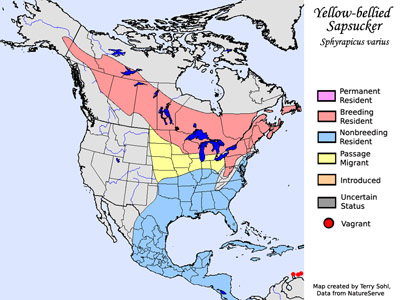 |
| South Dakota Status: Uncommon migrant and summer breeder in the far eastern part of South Dakota. Becoming increasingly rare as a migrant as you move westward in the state. |
Additional Yellow-bellied Sapsucker Photos
Click for a higher-resolution version of these photos

